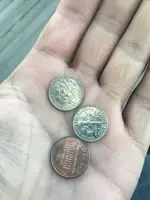jude061
Full Member
- Joined
- Mar 5, 2013
- Messages
- 214
- Reaction score
- 209
- Golden Thread
- 0
- Primary Interest:
- All Treasure Hunting
After countless hours of research, I decided to hit the woods where a 1690s village had been. I read old newspapers and town records, checked maps and survey plans, and nailed where the 1715 parsonage was before it burned in the 1870s. I got up early and hit the woods, bush whacking my way through cat briars that were tougher than barb wire. I found my landmarks -- an ancient cemetery in the woods, curves in the road, and random piles of rocks. I scoured every depression in the land that might be a cellar hole. Four hours later, months of research paid off. Just kidding -- all I found was a bud light cap -- and a recent one at that.

And that was a surface find. Back to the books, folks.

And that was a surface find. Back to the books, folks.
Amazon Forum Fav 👍
Upvote
13





